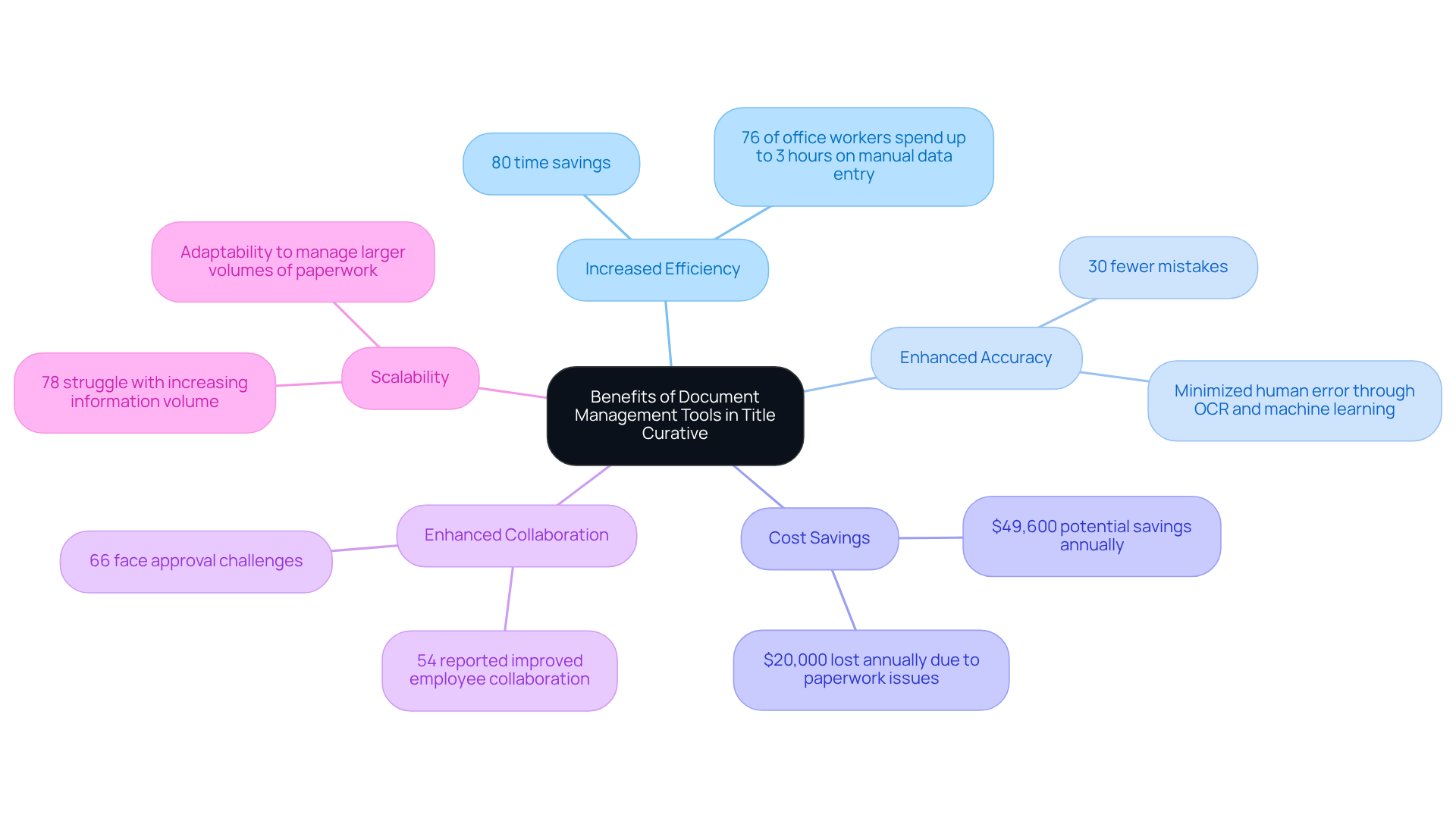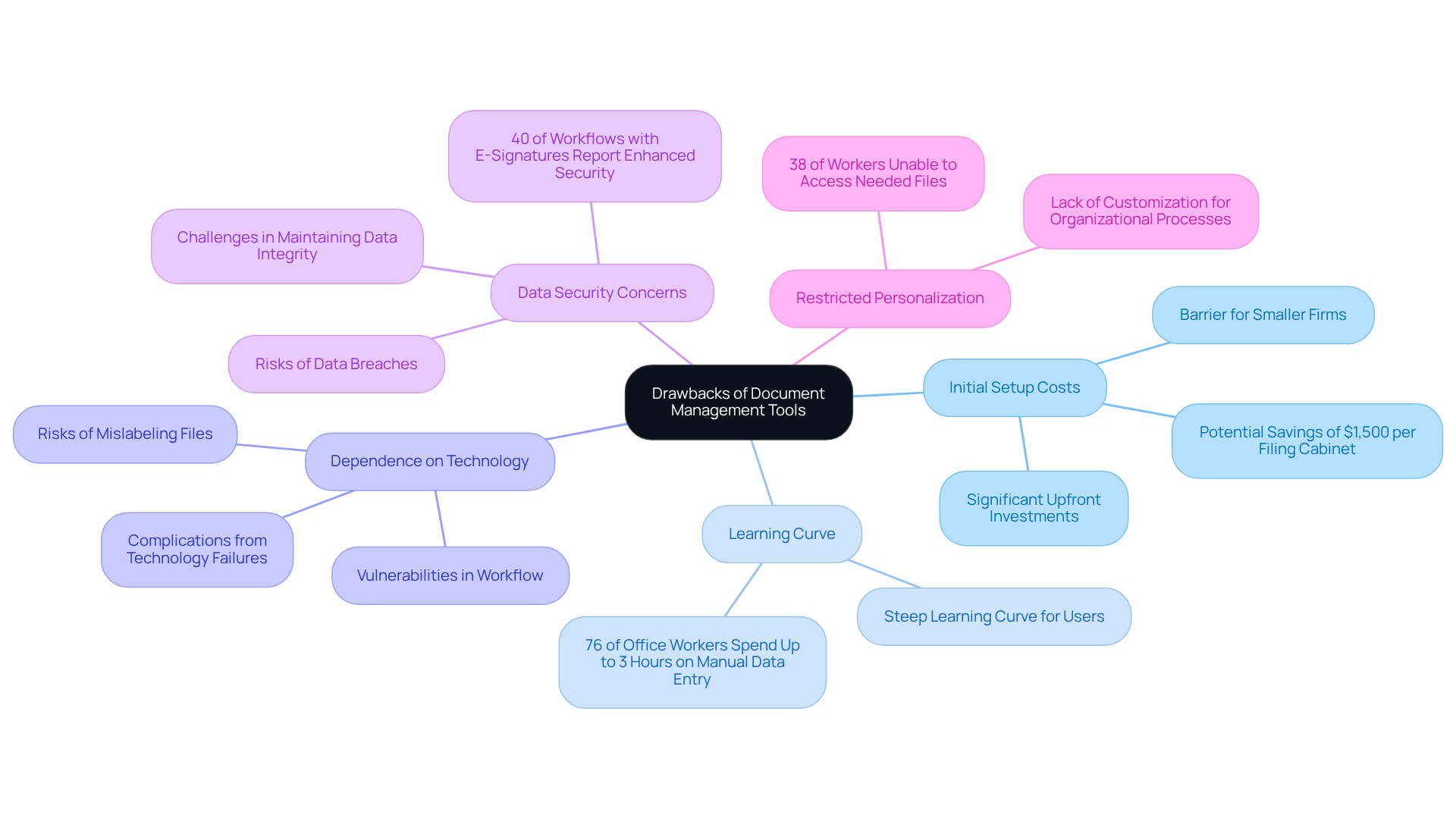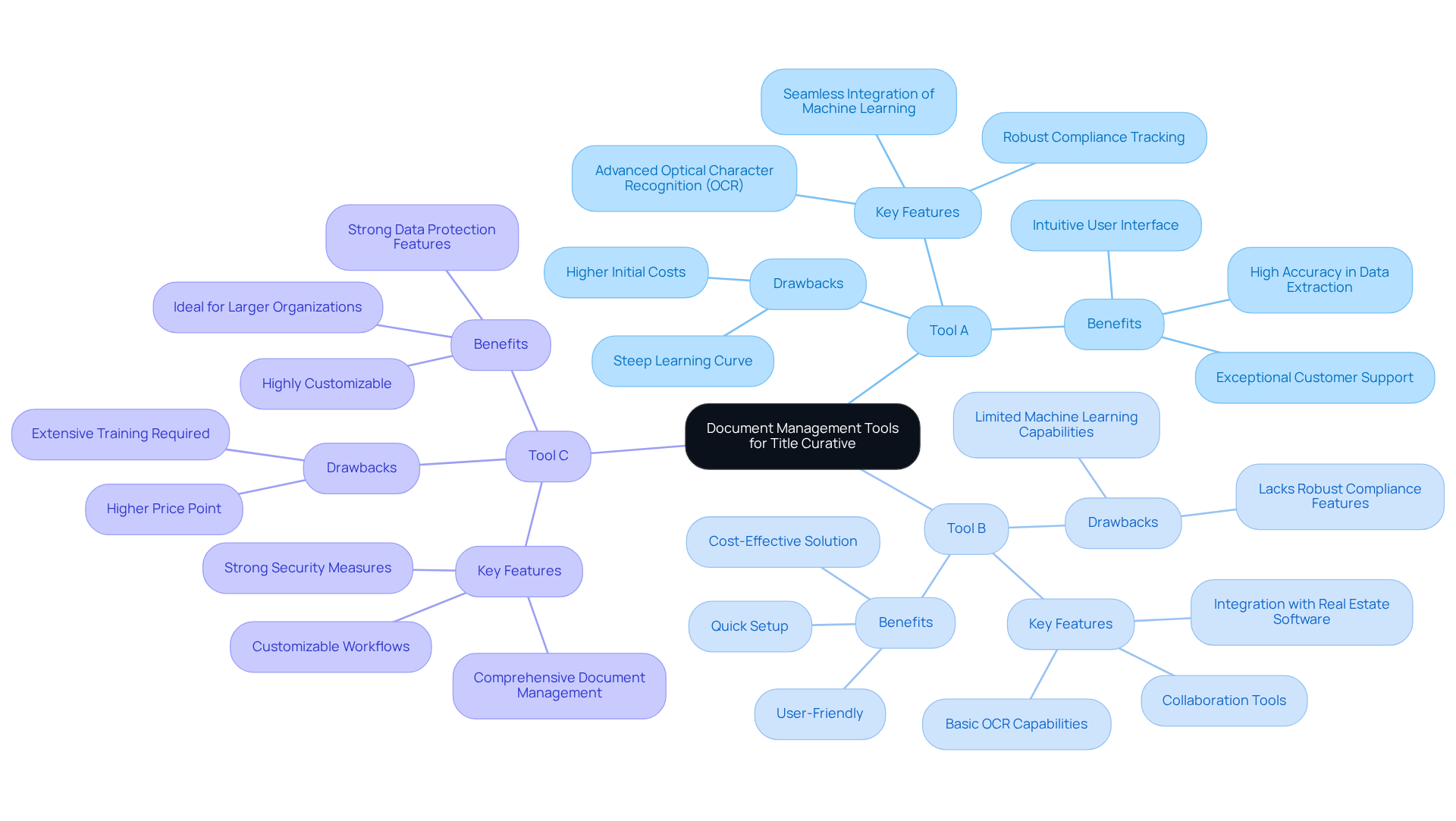Overview
This article presents a comparative analysis of document management tools specifically designed for title curative processes, underscoring their key features, benefits, and limitations. It highlights the critical role these tools play in enhancing efficiency and accuracy in title research.
Furthermore, it addresses potential drawbacks, such as initial costs and data security concerns, providing a comprehensive overview for professionals in the field. By understanding these dynamics, stakeholders can make informed decisions that ultimately improve their operations.
Introduction
The landscape of document management tools for title curative is rapidly evolving, driven by an urgent demand for efficiency and accuracy in title research. With advanced features such as Optical Character Recognition and machine learning algorithms, these tools are set to revolutionize how professionals manage extensive documentation.
However, as organizations evaluate the benefits against potential drawbacks, critical questions emerge:
- How do these systems genuinely influence productivity and compliance?
- What challenges must users navigate to fully leverage their capabilities?
This comparative analysis explores the essential functionalities, advantages, and limitations of leading document management solutions, providing title curative specialists with the insights necessary to make informed decisions.
Key Features of Document Management Tools for Title Curative
play a crucial role in enhancing the efficiency and accuracy of title research, featuring several key components:
- : This technology transforms scanned documents into editable and searchable text, significantly expediting the extraction of pertinent information from title documents. The OCR market is projected to grow from $14.49 billion in 2024 to $16.73 billion in 2025, fueled by increasing digitization initiatives. Moreover, the rapid growth of the in recent years underscores its essential role in modern document management.
- : Advanced tools employ machine learning to enhance over time. By learning from user interactions and historical data, these algorithms refine their processes, ensuring more reliable outcomes.
- Collaboration Tools: Many platforms incorporate features that promote teamwork, such as shared workspaces, comment sections, and version control. These tools are vital for maintaining consistency and precision in research, especially when multiple team members are involved.
- Integration Capabilities: The ability to integrate with other real estate software systems, such as CRM and GIS, is essential for streamlining workflows. This ensures that all relevant data is accessible in one location, thereby .
- : Tools that facilitate adherence to legal requirements and industry standards are critical for mitigating risks associated with ownership research. Given that 72% of enterprises utilize a mix of paper-based and digital processes, having robust compliance features can significantly reduce potential liabilities.
Together, these features simplify the curative process, enabling professionals to effectively manage extensive amounts of documents with document management tools for title curative while ensuring precision in their conclusions. Practical examples, such as , illustrate how these technologies can lead to in research. Furthermore, it is noteworthy that 46% of small businesses waste time daily due to paper-intensive processes, highlighting the inefficiencies that OCR aims to resolve. Document-related challenges contribute to a 21.3% decline in productivity, further reinforcing the necessity for enhanced resources in research.
Benefits of Utilizing Document Management Tools in Title Curative
Utilizing is essential for and accuracy. These tools offer numerous benefits, including:
- Increased Efficiency: significantly reduces the time required to complete title searches and curative actions. Research indicates that organizations can save up to 80% of the time spent on manual file sharing by implementing these systems. Furthermore, 76% of office workers spend up to three hours per day performing manual data entry tasks, underscoring the critical need for efficiency improvements.
- Enhanced Accuracy: The integration of optical character recognition (OCR) and machine learning , ensuring that the information gathered from files is both trustworthy and precise. Businesses experience 30% fewer mistakes when utilizing record control systems, which is vital for maintaining compliance and avoiding costly errors.
- Cost Savings: allows organizations to save on labor costs while allocating resources more effectively. A standard-sized company could potentially save around $49,600 annually by implementing records systems. In contrast, firms lose an estimated $20,000 each year due to paperwork issues, highlighting the financial ramifications of inadequate record handling.
- Enhanced Collaboration: among team members, leading to more cohesive and informed decision-making. This is particularly crucial in environments where 66% of companies face challenges with approvals and reviews. In addition, 54% of companies reported enhanced employee collaboration as a result of digitization.
- Scalability: As real estate activities expand, these resources can seamlessly adapt to manage larger volumes of paperwork without a corresponding increase in labor costs. With 78% of organizations identifying the growing volume and variety of information as a significant challenge, this adaptability is essential for sustaining efficiency in a rapidly evolving market.
These advantages position document management tools for title curative as essential resources for experts aiming to enhance their workflows and overall efficiency.

Drawbacks and Limitations of Document Management Tools for Title Curative
While offer numerous benefits, they also present notable drawbacks and limitations that professionals must consider.
- Initial Setup Costs: Implementing a new document management system often entails , including software acquisition, training, and integration with existing workflows. Companies can save at least $1,500 per filing cabinet each year by transitioning to these systems; however, these costs can still pose a barrier for many organizations, .
- : Adapting to new technologies can create a steep learning curve for users, potentially hindering productivity during the transition. Research indicates that 76% of office workers spend up to three hours per day performing manual data entry tasks, which can exacerbate this challenge.
- : An over-reliance on automated systems may lead to complications if technology fails or if data accuracy issues arise, necessitating manual oversight. This reliance can generate vulnerabilities in the workflow, as mislabeling files can result in reputation problems.
- : Storing sensitive title files digitally raises significant concerns regarding data breaches and unauthorized access. While 40% of workflows utilizing electronic signatures reported enhanced security for files, many organizations still encounter difficulties in maintaining data integrity.
- : Certain resource handling systems may lack the necessary customization to fit particular organizational processes, leading to inefficiencies. This limitation is underscored by the fact that 38% of workers assert their organizations are unable to provide the access they need to files.
Acknowledging these constraints is essential for curative specialists as they assess the benefits and drawbacks of utilizing document management tools for title curative.

Comparative Analysis of Leading Document Management Tools for Title Curative
In this analysis, we examine three prominent document management tools utilized in title curative processes, each offering distinct features and capabilities:
-
Tool A:
- Key Features: This tool boasts (OCR), seamless integration of machine learning, and robust compliance tracking mechanisms.
- Benefits: Users benefit from , an intuitive user interface, and exceptional customer support.
- Drawbacks: However, it comes with higher initial costs and presents a steep learning curve for new users, which may deter some organizations.
-
Tool B:
- Key Features: Tool B offers basic OCR capabilities, collaboration tools, and integration with widely-used real estate software.
- Benefits: It serves as a cost-effective solution for smaller teams, is user-friendly, and allows for quick setup.
- Drawbacks: On the downside, it has limited machine learning capabilities and lacks robust compliance features, which may be critical for larger operations.
-
Tool C:
- Key Features: This tool provides , customizable workflows, and .
- Benefits: It is highly customizable, making it ideal for larger organizations, and offers strong data protection features.
- Drawbacks: The trade-off is a higher price point and the potential need for extensive training to maximize its capabilities.
This comparative examination highlights the strengths and weaknesses of each resource, enabling title curative professionals to select the that align best with their operational needs and budget limitations. As the , with a compound annual growth rate (CAGR) of 13.8% from 2025 to 2029, selecting the right tool is more crucial than ever.

Conclusion
The exploration of document management tools for title curative processes reveals their indispensable role in enhancing operational efficiency and accuracy. By integrating advanced technologies such as optical character recognition and machine learning, these tools empower professionals to streamline workflows, reduce errors, and ultimately save valuable time and resources. The comparative analysis of leading tools underscores the importance of selecting the right system that aligns with organizational needs and budget constraints.
Key insights from the article highlight the myriad benefits these tools offer, including increased efficiency, enhanced accuracy, and significant cost savings. Furthermore, the ability to foster collaboration and scalability ensures that teams can adapt to growing demands without compromising performance. However, it is crucial to acknowledge the potential drawbacks and limitations, such as initial setup costs and data security concerns, which can impact the decision-making process for firms considering these solutions.
In light of the rapid growth projected for the document management system market, it is vital for organizations to carefully assess their options and invest in tools that not only enhance productivity but also secure their data integrity. Embracing these technologies can lead to transformative improvements in title curative processes, ultimately positioning firms for success in an increasingly competitive landscape.
Frequently Asked Questions
What are document management tools for title curative?
Document management tools for title curative are software solutions that enhance the efficiency and accuracy of title research by managing and organizing title documents.
What is Optical Character Recognition (OCR) and why is it important?
OCR is a technology that converts scanned documents into editable and searchable text, significantly speeding up the extraction of relevant information from title documents. It is crucial for modern document management due to the increasing digitization of processes.
How is the OCR market projected to grow?
The OCR market is expected to grow from $14.49 billion in 2024 to $16.73 billion in 2025, driven by rising digitization initiatives.
How do machine learning algorithms enhance document management tools?
Machine learning algorithms improve data extraction accuracy over time by learning from user interactions and historical data, which leads to more reliable outcomes.
What collaboration features do these tools offer?
Document management tools often include shared workspaces, comment sections, and version control to promote teamwork and maintain consistency and precision in research among multiple team members.
Why are integration capabilities important in document management tools?
Integration capabilities allow these tools to connect with other real estate software systems, such as CRM and GIS, streamlining workflows and ensuring that all relevant data is accessible in one place, enhancing productivity.
What role does compliance tracking play in document management?
Compliance tracking features help ensure adherence to legal requirements and industry standards, reducing risks associated with ownership research and potential liabilities.
What percentage of enterprises use a mix of paper-based and digital processes?
72% of enterprises utilize a combination of paper-based and digital processes.
How do document-related challenges affect productivity?
Document-related challenges can lead to a 21.3% decline in productivity, emphasizing the need for enhanced resources in research.
Can you provide an example of how OCR technology improves workflow efficiency?
An example is Parse AI's application of OCR, which demonstrates how the technology can lead to significant cost reductions and improved workflow efficiency in title research.




